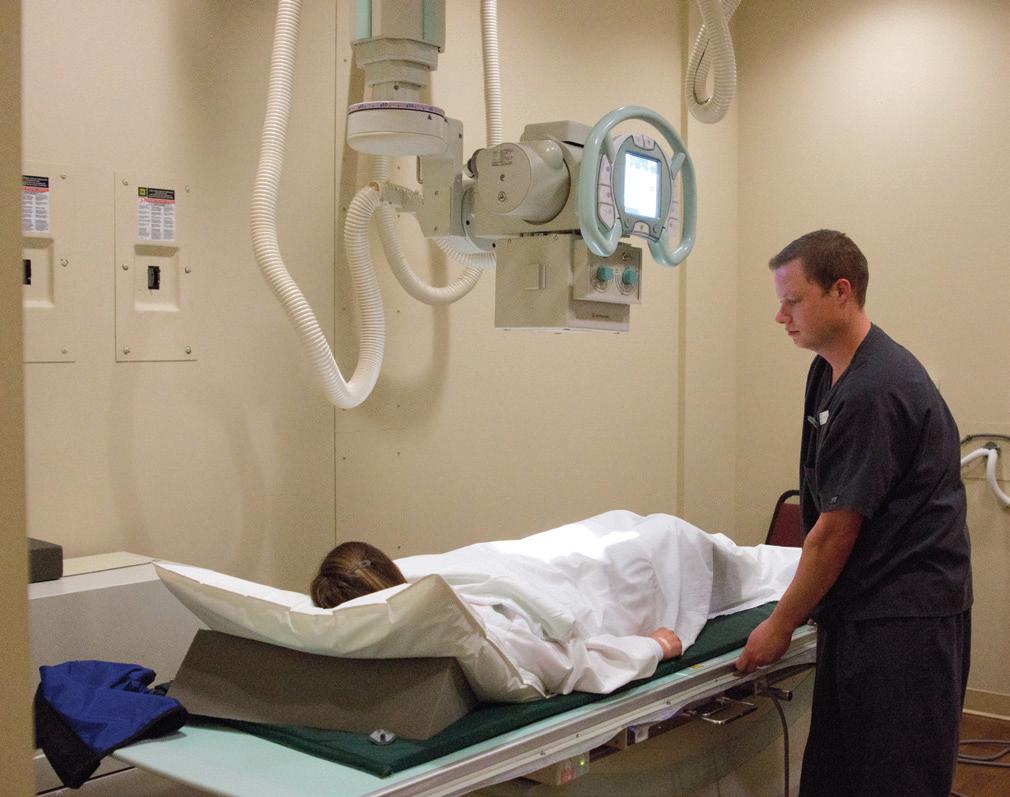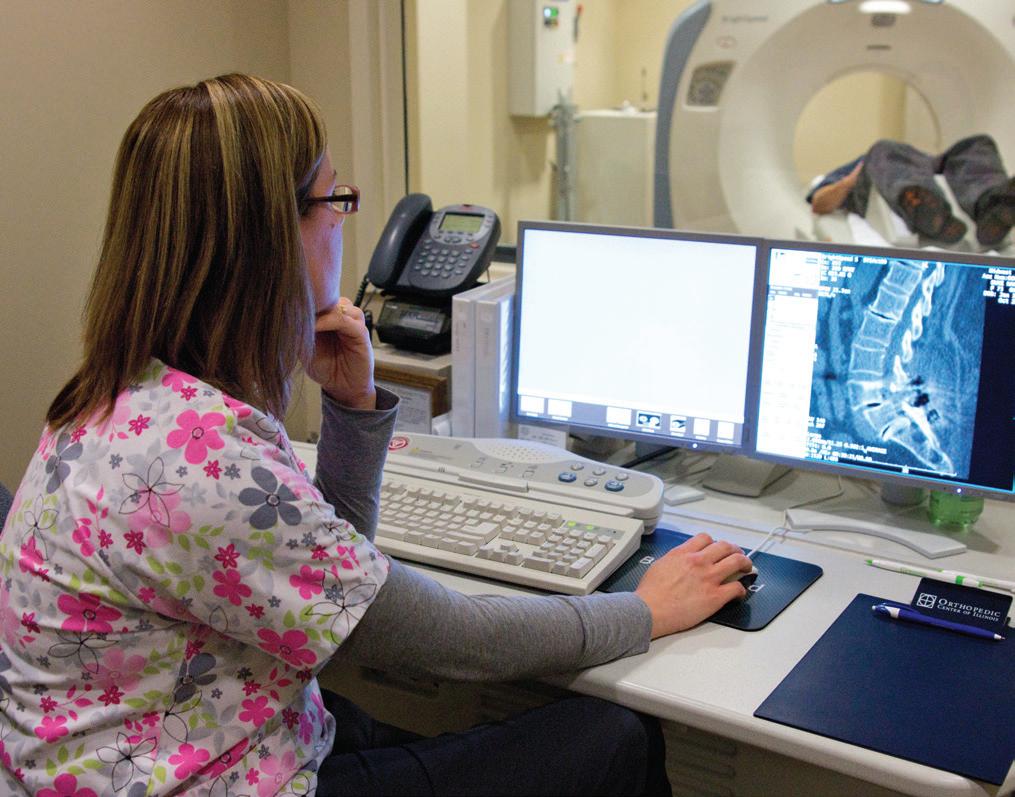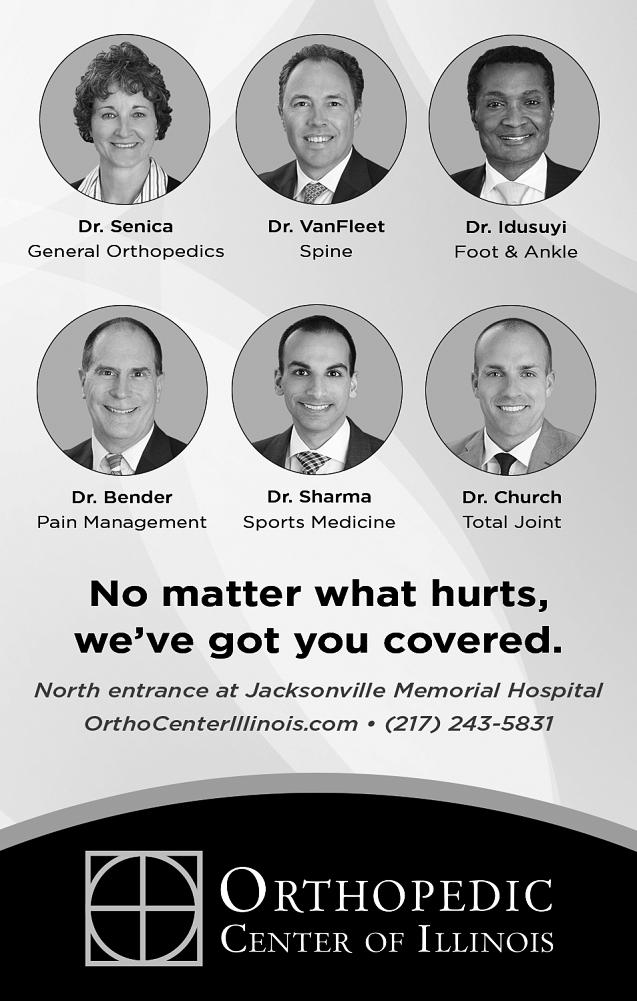Health Quarterly



A Special Supplement to the





A Special Supplement to the

and facet arthritis.
There are multiple orthopedic imaging techniques used to diagnose and evaluate musculoskeletal conditions. These include x-rays, CT scan, and MRI. This article will discuss the various techniques, and briefly, how these images are obtained. It will also describe the advantages and disadvantages of the various modalities and how they are used to evaluate common orthopedic conditions.

X-rays are the most commonly used imaging modality. They were first discovered in 1895, and they were produced with an x-ray machine or tube. Electrons, which are negatively charged subatomic particles, are accelerated and strike a metal target within the tube. This produces an x-ray beam which is projected through the body and onto an image detector. Objects that are more dense, such as bone, absorb more radiation while objects that are less dense, such as soft tissue, absorb less radiation.
Images can be detected with analog (x-ray film) or digital systems directly on the computer. OCI uses digital radiography. Some advantages of digital radiography include: immediate availability of images,
enhancement of images such as magnification, contrast, and taking direct measurements for templating. This system also leads to fewer retakes of x-rays and often times, a decreased radiation dose to the patient. It also offers storage of images on the computer without having to store volumes of x-ray films.
Besides being the most common imaging modality, x-rays are relatively inexpensive. X-rays can be used to diagnose fractures and dislocations, and also to assess fracture healing. Tumors and infections can also be identified on plain x-rays. One of the most common conditions we use x-rays for is to diagnosis arthritis and to assess its severity. They can also be used to assess alignment of total joint arthroplasties and to check for any evidence of loosening.
Orthopedic hardware such as plates, screws, and rods can also be visualized on x-ray. We can then determine if there is any malalignment, breakage, or loosening. X-rays can also be used in the spine
to evaluate for arthritis, degenerative disc disease, and curvature or scoliosis. Real-time imaging or fluoroscopy can also be used to perform injections and aspirations of joints.
Some disadvantages of x-rays are radiation exposure. X-rays are avoided in pregnancy unless absolutely necessary. X-rays are not helpful for identifying soft tissue injuries to ligaments, tendons, or muscle.
CT scans or computed tomography uses x-ray beams to take multiple slices of an object. These multiple images are reassembled to generate an image and can even be reconstructed on the computer to make a 3- dimensional image. Multiple images do improve resolution and provide soft tissue imaging as well. There is no magnification associated with CT scanning. Some disadvantages of CT scanning include increased radiation exposure and artifact noted on the images around metal orthopedic hardware or total joint
prostheses. CT scans in Orthopedics are used to evaluate complex fractures of the knee, pelvis, wrist, etc., for surgical planning. They can sometimes detect occult fractures which are not visible on plain x-rays or fractures that are sometimes hard to identify on plain film such as those involving the pelvis or sternoclavicular joint. They can be used with contrast dye to identify problems in the shoulder (rotator cuff tear) or knee (meniscal tear) in patients who are unable to have an MRI scan. CT scans can also be used as guidance to perform a bone biopsy.
MRI or magnetic resonance imaging involves using a tube surrounded by a giant circular magnet to obtain images. Our bodies are composed mostly of water, H2O, which contains hydrogen atoms. A strong magnetic field is sent through our bodies and changes the orientation of these hydrogen atoms. When they relax to their baseline state, there is energy released. This is picked up by a scanner and a computer to produce

images. MRI scanning provides excellent imaging of soft tissues including tendons, ligaments, menisci, and muscle. It also can be used to evaluate the bone marrow. Since it uses a large magnet for production of images, there is no radiation exposure.
The MRI at OCI is a short bore magnet measuring only 4 feet in length. The opening of the bore measures 2.3 feet in diameter with almost 1 foot of free space between the patient’s head and the magnet. The short bore design reduces feelings of claustrophobia, and the magnet allows more than 60 percent of exams to be completed with the patient’s head outside the bore. The strength of the magnet is 1.5 Tesla which produces superior image quality. The image quality is markedly better than on a conventional open MRI. MRI scans are used to determine ligament, tendon, or cartilage injuries in joints. They are used in the spine to detect disc herniations or degeneration, nerve root impingement or stenosis,
MRI scans can detect changes in the bone marrow that are seen in fractures, bone bruises, infections, or stress reactions. They can be used to identify bone and soft tissue tumors. MRI scans can also be performed with contrast (gadolinium) injected into the shoulder or hip joint to detect labral tears. Before having an MRI scan, patients are screened for any metal implants in their bodies. The strong magnet can cause electrical devices such as pacemakers and metal pumps to malfunction. Metal foreign bodies near the eye or brain could potentially move causing blindness or brain injury. Metallic orthopedic hardware and total joint prostheses attached to the bone are stable and can be imaged. All metal, such as jewelry, earrings, piercings, watches, hearing aids, cell phones, etc. are removed from your body prior to entering the scanning room. Disadvantages of MRI scanning include poor image quality related to patient motion artifact. Patients need to remain very still during the scan. This is sometimes difficult given the time required for scanning and because of claustrophobia. Patients are often given some Valium an hour prior to the exam to help with relaxation. Also, artifact from metallic hardware and prostheses can reduce image quality. MRI scanning is not approved during pregnancy.
modifications and supplements, including iron and folic acid.
Of the millions of women who become pregnant in the United States each year, most can expect to have healthy pregnancies and deliveries. A small percentage of women, however, will develop pregnancy complications.
A pregnancy complication is a health problem occurring during pregnancy that can potentially harm the mother, baby or both. Some women will also have health problems before becoming pregnant that can affect their pregnancy. Here are some common pregnancy complications our OB-GYN providers at SIU Medicine help pregnant women prevent and manage.
Anemia happens when a pregnant person has low levels of red blood cells. Red blood cells are critical for carrying oxygen from the lungs to other parts of the body. In pregnant women, anemia may present with signs and symptoms like fatigue, shortness of breath, faintness or lightheadedness and a pale appearance.
As with all pregnancy complications, anemia will be closely monitored by a woman’s health care provider throughout pregnancy. Treatment may include dietary
Severe morning sickness (hyperemesis gravidarum)
Most of us have heard about morning sickness in pregnancy, especially within the first trimester. It’s thought that rapidly rising levels of a hormone released by the growing placenta, called HCG (human chorionic gonadotropin), may cause this uncomfortable issue.
But while mild morning sickness usually does not pose any serious problems, some women develop severe and persistent nausea and vomiting, which can lead to complications like dehydration, weight loss and fetal malnourishment. Severe morning sickness, known as hyperemesis gravidarum, can be managed through approaches like eating bland foods and taking anti-nausea medications. In extreme cases, some women may require hospitalization for additional intravenous (IV) fluids and nutrients.
According to the U.S. Office on Women’s Health, more than half of women will develop a urinary tract infection (UTI) at some point in their lives.
UTIs, which happen when bacteria infect the urinary tract, can be particularly uncomfortable during pregnancy. Classic signs and symptoms include frequent, painful and/or

burning urination along with abdominal, pelvic, flank and lower back pain. A woman may also experience chills or fever.
It’s important to be treated for a UTI if you experience one during pregnancy, as untreated UTIs may lead to further complications like kidney infections or preterm labor. Other types of infections, including respiratory infections like COVID-19 and sexually transmitted infections (STIs), also require treatment from your doctor.
Some women have depression or other mental health conditions prior to pregnancy, which can exacerbate their symptoms. Others develop persistent symptoms of depression during pregnancy, which can include decreased interest in usually enjoyable activities, difficulty concentrating or making decisions and feelings of sadness,
with preeclampsia may experience high blood pressure, stomach pain, dizziness, headaches, blurry vision, swelling in the hands and face and increased protein in the urine.
Preeclampsia can require very close monitoring including bed rest, medications and even hospitalization. Induced labor is often necessary.
becoming pregnant— is associated with an increased risk of other pregnancy complications, including gestational diabetes, preeclampsia and congenital defects in babies.
worthlessness, guilt and irritability.
Women who have depression during pregnancy may struggle to care properly for themselves and their babies, and may be more at risk for postpartum depression, too. If you’re concerned about your mental health before, during or after your pregnancy, let your doctor know. They can help you determine the safest and most effective treatment for you and your baby, which may include psychotherapy, stress management techniques and medication.
Preeclampsia is a dangerous and potentially life-threatening pregnancy complication associated with high blood pressure, kidney problems and other concerns. It usually develops sometime after the 20th week of pregnancy. Women
Gestational diabetes occurs when a woman has too much sugar in her blood during pregnancy. It’s common to have no symptoms, but some women notice increased thirst, urination, hunger and/or fatigue. Having gestational diabetes increases the risk of additional complications, including preterm birth, cesarean (C-section) delivery, preeclampsia, having a large baby or having a baby born with breathing problems, jaundice or very low blood sugar.
Typically, prenatal care providers screen for gestational diabetes. Treatment generally includes diet and exercise interventions. Medication may be necessary if a woman is unable to control her blood sugar levels through diet and exercise alone.
It’s normal and healthy to gain some weight during pregnancy. But gaining too much—or being overweight or obese before
Your doctor can help you determine how much weight is an appropriate amount for you to gain based on your current weight and body mass index (BMI). Getting to a healthy weight before becoming pregnant has also been shown to be beneficial for expecting moms and their babies.
Placenta previa occurs when the placenta partially or completely covers the opening of the cervix inside a pregnant woman’s uterus. Some women will have no symptoms, while others may experience painless vaginal bleeding in the second or third trimester.
Placenta previa increases the risk of severe bleeding during labor and delivery, which can be lifethreatening. Management of this condition varies, but may include bed rest or restricting activity, hospitalization (if vaginal bleeding is heavy) or cesarean delivery.
If you’re looking for a prenatal provider who can help you feel more confident and comfortable throughout your pregnancy journey, find a doctor today at SIU Medicine by visiting siumed.org or by calling 217-545-8000.
Among the tall grasses and wildflowers that sprout each spring and summer lies a stealth predator just waiting for its chance at an easy meal. Ticks may be small in stature, but their impact on bite victims is potentially significant. Preventing Lyme disease and other tickborne illnesses comes down to following some key steps.

· Learn how common Lyme disease is. Lyme disease affects an estimated 476,000 people each year in the United States alone, according to the Center for Disease Control and Prevention’s Division of Vector-Borne Diseases. Lyme disease is most common in New England, the mid-Atlantic states and the upper Midwest.
Between 2009 and 2022, the Government of Canada reported 17,080 human cases of Lyme disease across Canada. However, instances of Lyme disease are likely underreported due to undiagnosed cases.
· Know which ticks carry Lyme disease. The blacklegged deer tick and the Western black-legged tick carry the Lyme disease spirochete. The black-legged tick is native to the northeastern, mid-Atlantic and north-central U.S., while the western black-legged tick is found on the Pacific coast.
· Wear light-colored clothing outdoors. When traveling in areas where ticks reside, it is important to wear light-colored
clothing. Long pants and tall socks, long-sleeved shirts, and hats also should be worn. It is easier to spot ticks on light-colored clothing, and covering up prevents ticks from gaining
easy access to skin.
· Know where to expect ticks. John’s Hopkins Medicine says black-legged ticks live in moist and humid environments, particu-
larly in and near wooded or grassy areas. Walking through leaves and bushes or through tall grasses can disturb ticks and enable them to jump onto people or pets. To avoid ticks, walk in the center of trails and avoid tall vegetation.
· Be mindful of pets. Even if you do not venture outdoors into tick-laden environments, your dog may. He or she can carry ticks into the house where they may end up on you or other family members. Prescription tick repellent products are available from veterinarians, and there are topical solutions and collars that can keep ticks away.
· Remove ticks quickly and correctly. The CDC says if a tick is removed in less
than 24 hours from when it first attached, the chances of getting Lyme disease is very small. Remove a tick with fine-tipped tweezers as soon as it is noticed, being cautious to remove all mouth parts. Try not to squeeze the tick, as it can regurgitate saliva and other fluids when squeezed.
· Repel ticks when possible. Create less favorable conditions for ticks. Use a product containing DEET or permethrin on clothing to repel ticks. Some people use chemical-control agents on their properties to reduce the number of ticks in the yard. Discourage deer from the property, as they can carry many ticks, by erecting fences and removing vegetation that deer eat.

Gestational diabetes is a relatively common pregnancy complication— each year, as many as 10% of pregnancies occurring in the United States are affected by it, according to the U.S. Centers for Disease Control and Prevention (CDC).

If you are pregnant or thinking about becoming pregnant, it’s important to be aware of this condition so you’ll know what to look for and how to manage it.
Diabetes is a group of health conditions that affect the way the body uses blood sugar (glucose). Gestational diabetes is a specific type of diabetes that develops during pregnancy in people who didn’t previously have diabetes.
When a person has gestational diabetes, changes in the way their body produces and responds to certain hormones makes it difficult for blood sugar to get into cells where it can be used as energy. This causes blood sugar to build up in the blood—a condition called hyperglycemia. High blood sugar can have harmful effects on the pregnant individual and her baby.
Risk factors for gestational diabetes
It’s not fully clear what
causes gestational diabetes or why certain women are affected, but being overweight or obese prior to pregnancy may play a role. Other known risk factors for this pregnancy complication include:
• Sedentary lifestyle (not being physically active)
• Family history of diabetes, especially an immediate relative (e.g., parent or sibling)
• Personal history of gestational diabetes in a prior pregnancy, or a history of delivering a large baby (more than 9 pounds)
• Polycystic ovary syndrome (PCOS)
• Certain racial and ethnic backgrounds,
including American Indian, Asian American, Black and Hispanic
Gestational diabetes usually goes away after pregnancy, but it can cause complications for pregnant individuals as well as their babies.
For pregnant women, gestational diabetes can increase the risk of:
• Type 2 diabetes (the CDC estimates that about half of women who develop gestational diabetes will go on to develop type 2 diabetes)
• High blood pressure, as
well as a serious pregnancyrelated complication known as preeclampsia
• Delivery via cesarean section (C-section)
Babies born to individuals with gestational diabetes have an increased risk of:
• Excessive birthweight
• Preterm (early) birth and associated problems, including trouble breathing
• Low blood sugar levels shortly after birth
• Obesity and type 2 diabetes later in life
• Death before or shortly after birth
I was diagnosed with gestational diabetes— now what?
and your baby. Treatment for gestational diabetes generally includes dietary modifications, exercise, closer and more frequent monitoring (including at-home daily blood sugar monitoring—your doctor will teach you how to do this) and medications if necessary.
Can gestational diabetes be prevented?
Good news—healthy lifestyle choices before and during pregnancy may reduce your likelihood of developing gestational diabetes (even if you’ve had it before) and can improve outcomes for you and your baby in general! Here’s what the research recommends:
• Get to a healthy weight prior to pregnancy
• Stay active before and during pregnancy (with your health care provider’s supervision)
Gestational diabetes doesn’t usually come with any obvious signs or symptoms; a person might notice excessive thirst or urination. Fortunately, doctors routinely screen pregnant women for gestational diabetes as part of normal prenatal care (usually around the 24th to 28th week of pregnancy).
If you were diagnosed with gestational diabetes, it’s important to work with your health care provider closely. He or she will be able to guide you on the important steps you need to take to control your blood sugar and minimize the risk of complications for you
• Eat the right amount and kind of foods to avoid gaining too much weight during pregnancy and to consume enough nutrients for yourself and your baby (think: whole grains, veggies and fruit, lean protein and healthy fats like nuts and avocado)
Would you like to speak with a health care provider about gestational diabetes?
If you’re pregnant and have concerns about gestational diabetes or other common pregnancy complications, find a doctor at SIU Medicine today by visiting siumed.org or by calling 217-545-

Regain Your Independence with Occupational Therapy






Many patients recovering from surgery or an injury may have trouble returning to their usual routines. Tasks that were once performed regularly may now take some extra effort, no matter how basic or rigorous they may be. On the other end, children struggling to meet developmental milestones may find the same tasks challenging and frustrating. Occupational therapy can help patients of all ages regain their ability or learn new skills to function.
What is Occupational Therapy?
Occupational therapy is a goal-oriented treatment that enables patients of all ages to participate in daily activities or “occupations.” Sessions promote health, wellbeing, and participation through the incorporation of occupations to finetune motor skills and regain — or in the case of pediatric patients, learn — the ability to perform common tasks. These include activities many of us take for granted, such as taking care of yourself and your family, working, volunteering, going to school or classes, getting dressed, cooking, and eating.
Who needs Occupational Therapy?
Occupational therapy may be recommended for patients of all ages for various reasons. It can help older adults adapt to changes in their mobility, help someone return to their normal after an injury, and can help young children reach developmental milestones or overcome sensory issues. Occupational therapists specialize in numerous conditions and treatments, including:
• Childhood development
• Chronic conditions affecting everyday independence




• Coordination problems



• Elbow, hand, and wrist injuries



• Self-care activities including dressing, bathing, preparing meals, and workrelated activities
• Sensory dysfunction
• Social activities



What should I expect from Occupational Therapy?





For adults, the goal of occupational therapy is to return the patient to the life and activities they previously enjoyed. The occupational therapist will first examine the person’s medical history, living situation, and needs to


develop a plan and goals specific to the patient. The therapist will also work with caregivers or family members to offer guidance and training as the patient progresses and ultimately returns home.

Pediatric patients, on the other hand, are taught
Travel was once a key component of the picture working professionals created of their ideal retirements. While the COVID-19 pandemic put many retirement travel plans on hold in recent years, jetting off to distant locales is once again on retirees’ radars.
A 2022 survey from AARP found that individuals 50 and over were poised to not only get back on the road, but also spend significantly more money on travel. Prior to the pandemic, Americans 50 and over spent $7,314 annually on travel, according to data from AARP. By spring 2022, individuals in that same age bracket indicated a readiness to spend $8,369 on travel.
Eagerness to get back on the road, in the air or on
the high seas could make it easy to overlook some principles of safe travel. However, such an oversight could lead to complications that could make it hard to enjoy time away from home. The following tips can reduce the likelihood that seniors encounter trouble while traveling.

· Determine if any health issues are affecting your desired destinations. The Centers for Disease Control and Prevention has a website devoted to travel vaccines (cdc.gov/travel/ page/travel-vaccines), and that page can be an invaluable resource for individuals planning a vacation. What’s more, the CDC even provides a specific list of destinations and the latest travel health notices for each of those nations. That list, accessible at cdc.gov/
Make your 2023 New Year’s resolution a healthy one by getting your hearing evaluated. Many studies have shown that untreated hearing loss can advance dementia and cognitive decline.

Professional Full Service Audiological Clinic
travel/destinations/list can help seniors determine if there are any health-related safety issues in countries they hope to visit.
measures to ensure your health while away. In addition, a pre-trip doctor visit is a great time to refill prescriptions that you will need while you’re away.
In 2023, more insurance plans cover routine hearing examinations and hearing aids and most plans are accepted by Central Illinois Hearing including State of Illinois retirees and Teachers retirements Aetna plans.

1515 W Walnut #4, Jacksonville
· Speak to your physician. A pre-trip consultation with a physician can uncover any issues that might arise while you’re away. Such issues may be easily managed for domestic travelers who are not planning to visit any especially remote locations, but they will not necessarily be as easily navigated when traveling overseas. Physicians can recommend certain vaccinations or
· Take financial precautions as well. Of course, not all travel-related concerns are medical. Finances also require some pre-trip attention. Inflation has caused a sharp spike in the price of various commodities since the start of 2022, so travelers should study up on the cost of food and attractions at their destination to ensure they have
enough money to enjoy themselves. Baggage costs have risen significantly in recent years, so seniors traveling on a budget may want to pack less and do laundry while traveling in an effort to save money. In addition, the unpredictable nature of travel since the onset of the pandemic has underscored the utility of travel insurance. Seniors can look into travel insurance that could reimburse them in the case of delays or cancellations.
· Privately share your itinerary. Prior to depart-

ing, share your itinerary with friends and family. Avoid sharing the itinerary on social media platforms, which can make you a target for criminals at home and at your destination. The itinerary should include where you’re staying, the dates you’re visiting certain locations and the dates of activities you’ll be engaging in on your trip.
Seniors rediscovering the joy of traveling can take various measures to make their trips more safe.
behavioral, or social difficulties in the classroom and on campus
What causes acquired hearing loss in children?
The causes of hearing loss in children can be as simple as cerumen (ear wax) or as complex as damage to middle or inner structures after suffering trauma to the head.

Children’s Healthcare of Atlanta notes that over-thecounter ear wax removal drops can effectively clean ears and restore kids’ hearing, though such drops may need to be part of routine preventive health care measures. Ear infections,
encephalitis, excessive noise exposure, meningitis, the presence of a foreign body in the ear, and viral infections like measles or mumps also can contribute to hearing loss in kids. Physicians can direct treatment of hearing loss based on the cause of kids’ hearing loss, but it’s worth noting that some hearing loss may require long-term use of hearing aids, surgery or medication.

Though often seen as a byproduct of aging, hearing loss affects millions of children as well. More information about children and hearing loss can be found at asha.org.
Hearing loss is often associated with aging, and understandably so. Individuals from all walks of life undoubtedly have an aging friend or relative who has experienced some degree of hearing loss, and millions of seniors across the globe would admit to having some difficulty with their hearing. But hearing loss also can affect children and, if undiagnosed, it can have an adverse affect on nearly all aspects of their lives.
The World Health Organization estimates that, as of 2021, approximately 34
million children present with hearing loss that requires rehabilitation. Johns Hopkins Medicine notes that hearing loss in children can be present at birth or develop later in childhood. Hearing loss that develops later in childhood is known as acquired hearing loss, and parents can look for various signs that kids could be losing their hearing. The American Speech-Language-Hearing Association notes that the signs of hearing loss in children may include:
· Delayed speech and/or
language development
· Speech sound disorder: The ASHA notes that speech sound disorders include any difficulty or combination of difficulties with perception, motor production, or phonological representation of speech sounds and speech segments
· Difficulty in following or understanding instructions
· Frequent requests for repetition
· Use of increased volume
on devices, including televisions, personal music players and tablets
· Difficulty effectively expressing themselves: Children can exhibit difficulty expressing themselves verbally and/or via written language
· Frustration with communication breakdowns
· Feeling of exhaustion at the end of a school day
· Difficulties at school: Children with hearing loss may experience academic,
The human body is a well-oiled machine that is a wonder of biological efficiency when working properly. The body’s immune system is integral to keeping a person healthy, and it does that by recognizing foreign invaders, such as viruses and bacteria, and then launching an attack to eradicate them. Sometimes, however, the body treats outside substances as harmful when they’re really just nuisances. This is the case with allergens.
Allergens, according to eMedicine Health, trigger an immune system response to various substances the body deems harmful. In turn, the body overreacts to these substances, triggering allergic reactions. Allergic reactions may occur in one person and not another. The immune system produces antibodies, which can cause certain effects, including inflammation of the skin, sinuses, digestive system, or airways, depending on the allergen, according to the Mayo Clinic.
Many things can trigger allergies, and the Centers for Disease Control and Prevention estimates that more than 50 million people in the United States have allergies. Here’s a look at some of the more common allergies that tend to rear their heads when weather warms up.

The air is filled with pollen come the spring and summer. Freshly blooming grasses, trees, flowers, and even weeds
While hearing aids and cochlear implants are the major sources of help for people with hearing loss, there are many other devices and technologies available.
services have mushroomed. Computer-based captioning services are now common, low cost and available in real time. For example, Hamilton Cap-Tel and Caption Call telephones use voice recognition technology to provide a written text on a large easyto-read screen.

phone calls and any audio from the phone through their hearing aids.
produce an abundance of pollen this time of year. It may coat vehicles outside and make its way indoors when people throw open windows to enjoy warm breezes.
Pollen allergies are quite common and cause runny, stuffy nose, itchy eyes, sneezing, watery eyes, and itchiness of the skin or roof of the mouth in some instances. Decongestants tend to be recommended when pollen count is high. It’s also best to leave windows closed during these times.
Mold are very small fungi with spores that float in the breeze like pollen. Mold thrives in damp areas. Mold may grow unchecked after spring rains or in piles of damp leaves. It also can be found in musty basements or bathrooms. Using a dehumidifier indoors can help alleviate mold, but outdoors it may be a little more challenging to control. When doing yard work in damp areas, wear a mask to avoid breathing in spores.
Chances are the arrival of spring may trigger
the desire to do a little cleaning. In turn, it’s highly likely that dust will be disturbed, and along with it, dust mites. WebMD says dust mites are microscopic and people may not even know they are around. Keeping a home free of dusty items can reduce dust mite numbers. Also, cover mattresses, pillows and wash sheets weekly in hot water to help alleviate dust mite infiltration.
We tend to think of allergens in terms of small substances that are inhaled, but insects that are abundant in the warm weather can be troublesome, too. An insect sting or bite can cause hives, itching, swelling, shortness of breath, or even anaphylaxis. While there’s no definitive way to avoid all insects, people can opt against brightly colored clothes and scented lotions or cosmetics. Insect repellents and skipping sweet foods or beverages at outdoor meals also may help.
Allergens are common this time of year, and people can take caution to feel better if they suffer allergies.
Displaying spoken words as written text (captioning) can provide important benefits for people with hearing loss. At one time captioning was provided by human translators and used primarily for movies and television.
In recent years, with the development of automatic speech recognition, using artificial intelligence (AI), speech-to-text (STT)
InnoCaption, a recent entrant to the field of captioning services, is a free app for a mobile smartphone or device that can provide real-time captioning of any call. This service can be a great aid for people with hearing loss who may have difficulty hearing on their mobile phone. I addition, Hearing aids manufacturers developed hearing aids that can be paired to a smartphone to stream
Google, which owns YouTube, uses LiveTtranscribe to transcribe user uploaded videos to display text in more than 100 languages. Microsoft provides SST services in 85 languages and Zoom, the video conferencing service that became popular during the pandemic, is partnering with Otter and providing captioning during Zoom calls.
As computer based automatic speech recognition algorithms improve, SST services will provide even greater benefits to people with hearing loss throughout the world.
The prevalence of cancer is widely known. Affecting people of every ethnicity and across the socioeconomic spectrum, cancer poses a threat to people in all corners of the globe. And that threat could be more significant in the immediate future. Estimates from the International Agency for Research on Cancer indicate that the global population boom and the growth of the world’s aging population could result in more than 16 million cancer deaths each year by 2040.
The statistics surrounding global incidence rates for cancer are startling, which can give the impression that
cancer is an inevitability for hundreds of millions of people across the globe. However, there’s much individuals can do to reduce their cancer risk.
According to the MD Anderson Cancer Center, a healthy diet can help reduce cancer risk. A diet that focuses on plants and emphasizes healthy choices may not eliminate the threat of cancer, but it can be an integral component of a preventive health care regimen. With that in mind, the following are five fruits and vegetables associated with reducing cancer risk, courtesy of the MDACC.
1. Berries: Berries: contain antioxidants, which
protect the body from cell damage that can contribute to various cancers, including skin cancer, lung cancer and breast cancer, among others. Blueberries, raspberries and strawberries make wonderful additions to anyone’s diet.
2. Cruciferous vegetables: Cruciferous
vegetables include broccoli, bok choy, cabbage, and brussel sprouts, among others. The MDACC notes that studies have indicated that special plant compounds in cruciferous vegetables may protect the body from stomach cancer and cancers of the mouth, pharynx, larynx, and esophagus.
3. Garlic: The experts at Mount Sinai note that garlic is often linked with reduced risk for heart disease, notably the prevention of atherosclerosis, which affects the arteries through the deposition of plaques of fatty acids along the arterial walls. However, antioxidant-rich garlic also helps the body fight off harmful free radicals that can contribute to cancer.

4. Spinach: The Centers or Disease Control and Prevention notes that colorectal cancer is one of the leading causes of cancer deaths in the United States. Studies have found that spinach inhibits the growth of colon polyps that can develop into colorectal
cancer.
5. Tomatoes: Lycopene is an antioxidant that gives tomatoes their bright red color. According to the National Cancer Institute, though human studies have produced inconsistent results, various in vitro and animal studies have indicated that lycopene may have chemopreventive effects for cancers of the prostate, skin, breast, lung, and liver.
Eating these five fruits and vegetables is not the only way to use diet in the fight against cancer. Individuals are urged to speak with their physicians to learn about the many ways to utilize food in cancer prevention.
Ultraviolet radiation from the sun can prove harmful to the skin. UV rays have been linked to the formation of various skin cancers, including the dangerous melanoma. However, UV exposure also can cause issues elsewhere in the body, including the eyes.
The American Academy of Ophthalmology says everyone’s eyes are at risk of damage from UV light, regardless of their age or skin pigmentation. But some people are at higher risk. Children are included in the elevated risk group because they often play outside. Some studies also show that people with eye diseases like retinal
dystrophy or those who underwent surgery for cataracts may be at higher risk for sun damage.
UV light and eye disease
UV light damages cells in the eyes, particularly in the retina. The Cleveland Clinic says the retina is responsible for capturing light that enters the eye and translates it into the images you see. If the retina becomes damaged, vision can be impaired or even lost. Here are some additional eye diseases associated with UV radiation.
· Photokeratitis: This is the equivalent of a
sunburn on the surface of the eye. While it can occur during the summer, the sun reflecting off of snow or light-colored pavement also can contribute to photokeratitis at other
times of the year.
· Cataracts: UVB radiation can harm the lens of the eye and damage proteins. Over time, these proteins can clump together to form cataracts.
· Conjunctival cancer: This is a form of cancer that forms on the surface of the eye, known as the conjunctiva.
· Macular degeneration: This is the leading cause of vision loss among older people, according to NVision Eye Centers. The macula is the center of the retina. If this area becomes damaged, central vision will be compromised.
It’s easy to protect the eyes from UV rays. Individuals with blue or green eyes should keep in mind that they are at a high risk of UV damage. However, everyone should take precautions.

Look for sunglasses that protect against UVA and UVB rays, offering 99 to 100 percent protection (or UV400 rating). UVA rays harm central vision, while UVB rays can damage the front of the eye. Sunglasses should be worn when spending time outdoors. Sunglasses are available in all sizes, even for kids. Wraparound styles may
protect the eyes and sides of the face.
Wearing a wide-brimmed hat also can protect the eyes by filtering harmful light. Select a hat with a broad, dark brim that shades the eyes and reduces glare, advises the National Eye Institute.
Consider the use of UVblocking contact lenses. Some contact lenses offer UV protection, which can be an added precaution when used with sunglasses.
Another way to avoid UV eye risks is to stay away from tanning booths, mercury vapor lights and some types of halogen or fluorescent lights.